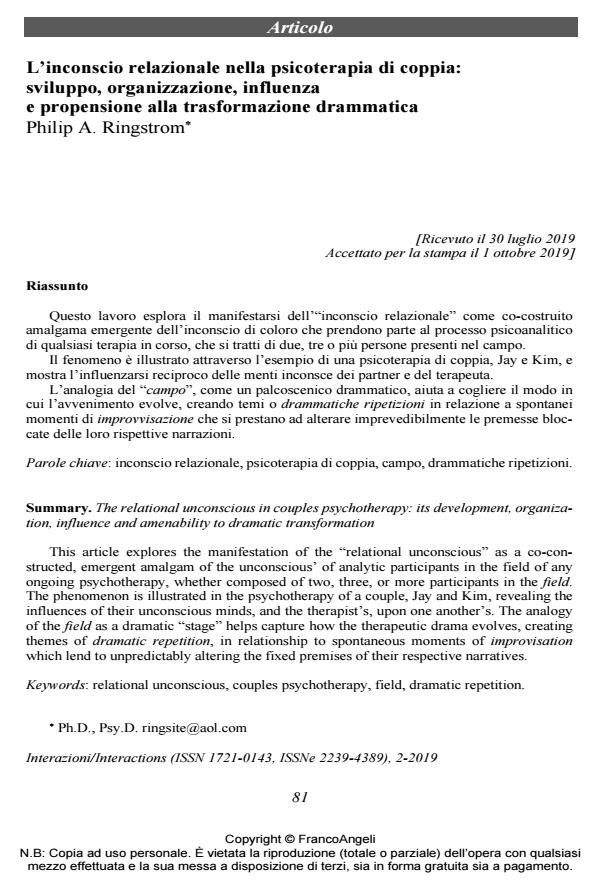The relational unconscious in couples psychotherapy: its development, organization, in-fluence and amenability to dramatic transformation
Journal title INTERAZIONI
Author/s Philip A. Ringstrom
Publishing Year 2019 Issue 2019/2 Language Italian
Pages 22 P. 81-102 File size 219 KB
DOI 10.3280/INT2019-002006
DOI is like a bar code for intellectual property: to have more infomation
click here
Below, you can see the article first page
If you want to buy this article in PDF format, you can do it, following the instructions to buy download credits

FrancoAngeli is member of Publishers International Linking Association, Inc (PILA), a not-for-profit association which run the CrossRef service enabling links to and from online scholarly content.
This article explores the manifestation of the "relational unconscious" as a co-constructed, emergent amalgam of the unconscious’ of analytic participants in the field of any ongoing psychotherapy, whether composed of two, three, or more participants in the field. The phe-nomenon is illustrated in the psychotherapy of a couple, Jay and Kim, revealing the influences of their unconscious minds, and the therapist’s, upon one another’s. The analogy of the field as a dramatic "stage" helps capture how the therapeutic drama evolves, creating themes of dramatic repetition, in relationship to spontaneous moments of improvisation which lend to unpredictably altering the fixed premises of their respective narratives.
Keywords: Relational unconscious, couples psychotherapy, field, dramatic repetition
- Yadlin-Gadot S. (2017). Truth matters: Theory and practice in psychoanalysis. Leiden, The Netherlands: Brill Rodopi.
- Ringstrom P.A. (2019). Dramatization, Narration, and Improvisation in Psychoanalytic Field Theory: Forty Years in Search of a Relational Metapsychology. New York, NY: Routledge, Taylor and Francis Group.
- Ringstrom P.A. (2018c). Relational Psychoanalytic Perspective on Couples Psychotherapy. Psychoanalytic Inquiry, 38, 5: 399-408. DOI: 10.1080/07351690.2018.1469914
- Ringstrom P.A. (2018b). Relational Metapsychology in a Three Dimensional Field Theory of Change: Reply to Gabbard, Gadot and Fosshage. Psychoanalytic Dialogue, 28, 4: 422-431. DOI: 10.1080/10481885.2018.1482142
- Ringstrom P.A. (2018a). Three Dimensional Field Theory: Dramatization and Improvisation in a Psychoanalytic Theory of Change. Psychoanalytic Dialogue, 28, 4: 379-396. DOI: 10.1080/10481885.2018.1482128
- Ringstrom P.A. (2017b). Psicoanalisi relazionale e terapia di coppia. Roma: Giovanni Fioriti Editore.
- Ringstrom P.A. (2017a). “É il caso o non è il caso”. Il diemma e la sfida del lavoro con i partner sia in individuale, sia in terapia di coppia. In Castellano R., Bonucci C. (a cura di), Una poltrona per tre. Pazienti e analista nella terapia di coppia. Milano: FrancoAngeli.
- Ringstrom P.A. (2014b). “Becoming an analyst: A Play in Three Acts” in Clinical Implications of the Psychoanalyst’s Life Experience: When the Personal Becomes Professional. Ed by Steven Kuchuck. New York, London: Routledge.
- Ringstrom P.A. (2014a). A relational psychoanalysis to couples psychotherapy. New York, NY: Routledge, Taylor and Francis Group.
- Ringstrom P.A. (2007b). Reply to Commentary by Daniel N. Stern. Psychoanalytic Dialogue, 17, 1: 105-113. DOI: 10.1080/10481880701302079
- Ringstrom P.A. (2007a). Scenes That Write Themselves: Improvisational Moments Relational Psychoanalysis. Psychoanalytic Dialogue, 17, 1: 69-99. DOI: 10.1080/10481880701301303
- O’Connell M. (2019). The Performing Art of Therapy: Acting Insights and Techniues for Clinicians. New York: Routledge.
- Gottman J. (1999). The marriage clinic: A scientifically based marital therapy. New York: W.W. Norton.
- Fosshage J. (2018). Discussion of “Three Dimensional Field Theory”. Psychoanalytic Dialogue, 28: 397-402. DOI: 10.1080/10481885.2018.1482129
- Fodor J. (1983). The modularity of mind. Cambridge, MA: MIT Press.
- de Botton A. (2016). Why You Will Marry the Wrong Person. New York Times, May 28, 2016.
- Bromberg P.M. (1998). Standing in the spaces: Essays on dissociation, trauma, and clinical process. Hillsdale, NJ: Analytic Press.
- Benjamin J. (2018). Beyond doer and done to: Recognition theory, intersubjectivity and the third. New York, NY: Routledge.
- Beebe B., Lachmann F.M. (2002). Infant research and adult treatment: Co-constructing interactions. Hillsdale, NJ: Analytic Press.
- L'estraneo dentro: il lapsus come segnale del Sé emergente Cristina Bonucci, in INTERAZIONI 1/2021 pp.87
DOI: 10.3280/INT2021-001007
Philip A. Ringstrom, L’inconscio relazionale nella psicoterapia di coppia: sviluppo, organizzazione, influenza e propensione alla trasformazione drammatica in "INTERAZIONI" 2/2019, pp 81-102, DOI: 10.3280/INT2019-002006